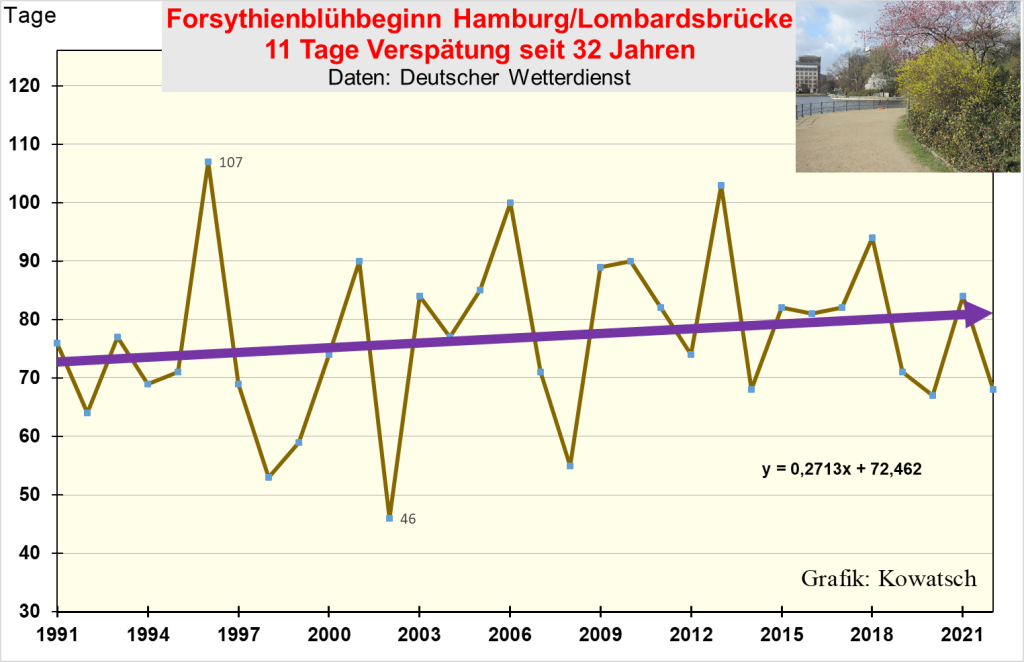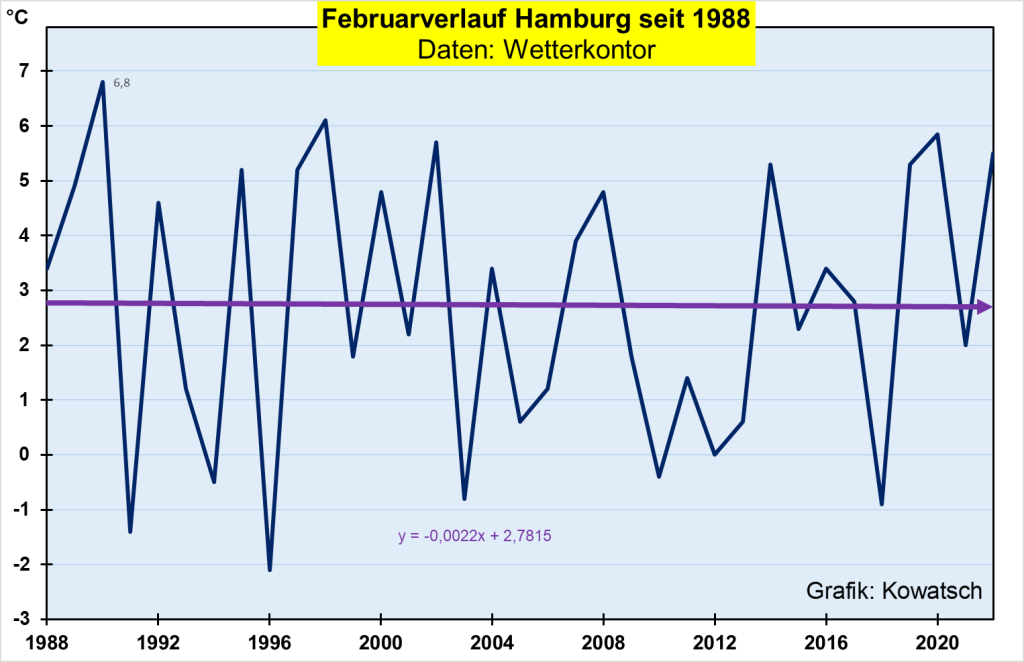By Josef Kowatsch (EIKE)
(Translated by P. Gosselin)
The beginning of spring in Germany is when the Hamburg forsythia shrub blooms in the city center.
Although a city center is always warmer than the surrounding area, the location on the Alster is well suited because it has had little building changes within a 2 km radius for 40 to 50 years. Hamburg has been growing outwards since then, which of course also leads to more warmth in the city center, but the influence is not as great as if additional changes in building had been added around the direct location of the forsythia.
Thus, the blooming data of this Hamburg shrub at the Lombard Bridge site are quite good over the last 50 years.
Warming believers claim:
1) a steadily earlier start of spring.
2) That spring 2022 would be particularly early.
3) That the reason for the warming would be the rising CO2 in the atmosphere, currently just below 420 ppm.
Phenologist Jens Iska-Holtz has been observing the forsythia bushes at the Alster in Hamburg for almost 40 years. Therefore, his data for blooming are readily comparable, as he uses a constant standard for comparison.
Using his criteria, the 2022 blooming date of the shrub in Hamburg was March 9, which is 68 days since the start of the year. Over the last 50 years, the chart plots out as follows:
Fig. 1: The X-axis are the years since 1973, on the Y-axis are the blooming dates measured in days after the beginning of the year, i.e. from January 1st.
The trend line is practically steady at 79 days after the beginning of the year. Observations:
- There hasn’t been a trend of spring arriving earlier over the past 50 years, at least at this location in Hamburg.
- However, this year’s spring onset was 10 days earlier. The claim that the phenological onset of spring this time was earlier than the average of the last 50 years is correct.
- Despite strong increase of CO2 concentrations over the last 50 years, we cannot observe any tendency for an earlier beginning of blooming at the Hamburg forsythia shrub, the DWD indicator shrub for the beginning of spring.
Using the climate unit of 30 years
We now take the new climate unit 1991 to 2020 as the period under consideration and add the last two years as a comparison, a total of 32 years. During this period, CO2 concentrations have increased by a good 60 ppm worldwide.
Fig. 2. Note: Rising trend line means lateness. At the beginning of the observation 32 years ago, forsythia tended to bloom at the end of February, and the blooming date has since moved further and further into March. The last February occurred in 2008.
So what explains the delay in spring over the past 30 years, i.e. since 1991 in Germany? Carbon dioxide?
This gas, vital for photosynthesis, has increased by about 60 ppm in the last 32 years and certainly has a stimulating and accelerating effect on the start of spring, but temperatures exert the greater influence. And for the forsythia bloom, the month of February is crucial.
The graph of the Hamburg weather station for the month of February below shows a slight, but insignificant cooling since 1988:
Fig. 3: February has shown almost a zero trend, an insignificant falling trend line for Hamburg for the last 35 years. February 2022 was relatively mild with 5.5°C in Hamburg.
Let’s move on to the question of since when has the Hamburg forsythia bloom been delayed?
Fig. 4: Rising trend line means bloom delay: Since 1985, i.e. for 38 years, the forsythia, the DWD’s showcase shrub for the beginning of spring in Hamburg’s city center, has shown a slight delay in flowering of 5 days. The reason for the rising trend line and thus the delay are the warm February months 1988/89/90 at the beginning of the period.
Conclusions
The forsythia bloom has become slightly delayed over the past 38 years, and quite clearly over the past 35 years – although the shrub is located in downtown Hamburg, in a urban heat island. Increasingly late spring blooming is exactly the opposite of what people in Germany are told.
In southern Germany, the forsythia bloomed much later in 2022, and February was not as mild as it was in the northern German lowlands. Especially in locations above 700 m, February was about as cold as last year.
License notice for forsythia photo in the upper right corner of Fig.. 1,2,4: Foto: NordNordWest, Lizence: Creative Commons by-sa-3.0 de, Forsythien an der Binnenalster.nnw, CC BY-SA 3.0 DE
Josef Kowatsch is an independent nature and climate researcher.









Flowers are smarter than an AGW believer?
Incidentally I noticed that agapanthus bloomed later this past summer than in the previous 18 years. Depending on position those on the side of a road bloomed 3 weeks before Christmas day and those back from the road in the week just before Christmas. This year (2021) both sets didn’t bloom until over a week after Christmas when they all flowered.
It might be that ordinary people were commenting about the cooler weather that summer (unlike NASA who claimed that Adelaide and surrounds were much warmer than usual.
” the new climate unit 1991 to 2020 ”
These periods are nothing more than standard reporting human artifacts. There use is about comparing averages of weather variables. Climate is a more complicated concept.
Still, the issue is interesting
My forsythia is mostly browsed by deer to the point of no blooms.
There seem to be big swings from min to max.
Exactly. This is why I regard linear regressions as worse-than-useless in these situations – and their being easy to do doesn’t make the results meaningful at all.
Take data like that and compute what the correlation coefficient is – Excel will give you that if you ask. If the correlation coefficient is small in magnitude, that means that the line drawn through the data is meaningless.
Hence my call for an end to meaningless linear regressions – to be replaced with proper statistical-trends analysis, capped with the Western Electric Rules.
Traditional folk knowledge, based upon long experience, beats today’s scientists:
Groundhog Day is celebrated — long, long celebrated — on February 2nd, EXACTLY in the middle of winter…I repeat, exactly. So even ancient people knew that spring could come that early, VERY early, and often enough to make the possibility of an early spring a tradition, every year.
By that very fact, modern folk should disregard any hint of hysteria, or even seriousness, over spring “arriving” only 10, or even 20, days early. Even ancient(!) farmers CELEBRATED the possibility, every year(!), with NO FEAR of “runaway climate” whatsoever.
Modern science, ever since Darwin with his undirected, bootstrap evolution theory, has utterly, completely lost its way (due to both its own crisis of incompetence, and the abuse of that incompetence by a runaway elite, particularly the illegitimate Insane Left Democrat party of Barack Obama et al.).
Looks like the mid 70s to mid 80’s cooling was nicely picked up by the forsythia bloom time. It would have been nice to see what the temp record said about that. In the article temps are only shown beginning in the late 80s, so we can’t see if there’s any correlation with the forsythia bloom date.
[…] Cooling Springs: Hamburg Phenological Spring Has Not Been Arriving Earlier Over Past 50 Years […]